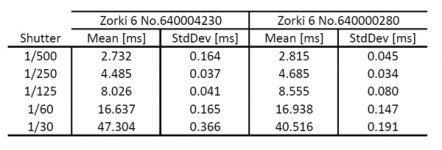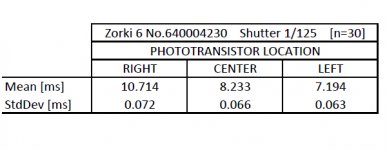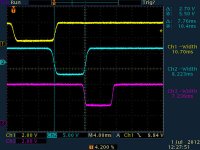You are using an out of date browser. It may not display this or other websites correctly.
You should upgrade or use an alternative browser.
You should upgrade or use an alternative browser.
zorki 6 - shutter time measured
- Thread starter brankop
- Start date
- Latest activity Latest activity:
- Replies 12
- Views 3K
V
varjag
Guest
Fairly consistent.
This confirms that the "new standard" 1/30 marking on the dial is still the old 1/25.
This confirms that the "new standard" 1/30 marking on the dial is still the old 1/25.
MartinP
Veteran
Excellent test results. 🙂
Have they been cleaned and adjusted recently, or are they of 'unknown' servicing history?
Have they been cleaned and adjusted recently, or are they of 'unknown' servicing history?
brankop
Member
The camera No. 640004230 was recently purchased on ebay so its history is unknown. The second one was not used for over 20 years. I recently started to use it without cleaning inside or adjusting.
Valkir1987
Well-known
Dear Brankop,
I would like to know wat device you used to measure the times and speeds. The table shows speeds in [ms] microseconds. Actually the curtains of both camera's run to slow, and their drums and shafts will need cleaning and lubrication.
Nothing confirms that the 1/30 on one camera is still the old 1/25. That could only be confirmed by measuring the distance of the slith with at 1/200 or 1/500.
This is just a matter of adjustment. Its the time where the second curtain closes when the first has reached the end of its travel.
I would like to know wat device you used to measure the times and speeds. The table shows speeds in [ms] microseconds. Actually the curtains of both camera's run to slow, and their drums and shafts will need cleaning and lubrication.
Nothing confirms that the 1/30 on one camera is still the old 1/25. That could only be confirmed by measuring the distance of the slith with at 1/200 or 1/500.
This is just a matter of adjustment. Its the time where the second curtain closes when the first has reached the end of its travel.
David Hughes
David Hughes
Hi,
Well, I don't want to sound rude, but I can't see that much can be drawn from measurements of this sort when we are talking about two second-hand cameras that must be about 50 years old and with an unknown history.
All I'd do with the measurements is decide if the things needed servicing or not. Their age and the lack of a FSH suggests it wouldn't do any harm if done by a camera technician.
Regards, David
Well, I don't want to sound rude, but I can't see that much can be drawn from measurements of this sort when we are talking about two second-hand cameras that must be about 50 years old and with an unknown history.
All I'd do with the measurements is decide if the things needed servicing or not. Their age and the lack of a FSH suggests it wouldn't do any harm if done by a camera technician.
Regards, David
wolves3012
Veteran
To be honest, all the figures show is the shutters are running slow, particularly at faster speeds. If the cameras are unknown or un-serviced, this doesn't come as a shock. It's not uncommon for shutters to run a bit on the slow side anyway.
Since you have access to the timing equipment, I'd make use of it by servicing the cameras and adjusting them to be as near correct as possible.
Since you have access to the timing equipment, I'd make use of it by servicing the cameras and adjusting them to be as near correct as possible.
brankop
Member
Hello all,
RE: used equipment
An IR diode + photo-transistor + high bandwidth oscilloscope.
RE: test
An missing information is that for each shutter speed, 10 experiment were done. A comment regarding the fast shutter speed: since the rising and falling edges of the photo-transistor output were not instantaneous, it is possible that the oscilloscope gave a bit biased measurement. I did not check what triggers the stopwatch: is it 10%, 50% or 90% amplitude of the observed signal. But then question is what would be the right amplitude.
RE: slow curtains
If you observe the first column, the shutter speed errors, relatively to dial numbers, are: +36.6%, +12.1%, 0.3%, -0.2% and 41.9%. To me, this implies that the error is not an linear function of the shutter speed. Can the curtains be adjusted for the each speed independently? Or one matches one shutter speed while other speed end up where they end up?
Best
RE: used equipment
An IR diode + photo-transistor + high bandwidth oscilloscope.
RE: test
An missing information is that for each shutter speed, 10 experiment were done. A comment regarding the fast shutter speed: since the rising and falling edges of the photo-transistor output were not instantaneous, it is possible that the oscilloscope gave a bit biased measurement. I did not check what triggers the stopwatch: is it 10%, 50% or 90% amplitude of the observed signal. But then question is what would be the right amplitude.
RE: slow curtains
If you observe the first column, the shutter speed errors, relatively to dial numbers, are: +36.6%, +12.1%, 0.3%, -0.2% and 41.9%. To me, this implies that the error is not an linear function of the shutter speed. Can the curtains be adjusted for the each speed independently? Or one matches one shutter speed while other speed end up where they end up?
Best
wolves3012
Veteran
Ok, so 10 measurements isn't statistically significant to be quoting SD really. Thirty is generally considered minimum for meaningful stats.Hello all,
RE: used equipment
An IR diode + photo-transistor + high bandwidth oscilloscope.
RE: test
An missing information is that for each shutter speed, 10 experiment were done. A comment regarding the fast shutter speed: since the rising and falling edges of the photo-transistor output were not instantaneous, it is possible that the oscilloscope gave a bit biased measurement. I did not check what triggers the stopwatch: is it 10%, 50% or 90% amplitude of the observed signal. But then question is what would be the right amplitude.
RE: slow curtains
If you observe the first column, the shutter speed errors, relatively to dial numbers, are: +36.6%, +12.1%, 0.3%, -0.2% and 41.9%. To me, this implies that the error is not an linear function of the shutter speed. Can the curtains be adjusted for the each speed independently? Or one matches one shutter speed while other speed end up where they end up?
Best
To answer the second part - no, you can't adjust speeds independently. Essentially, the only adjustment is the curtain tensions. Based on my experience, these shutters tend to run at the right speed provided the mechanisms are clean and properly lubricated. Of course "the right speed" means the speed determined by the slit-width, which is not readily adjustable. I don't mean "the exact speed marked". Messing with tensions doesn't have any major effect unless you go to extremes, at which point you won't have a consistent shutter. If you adjust the top speed to give a consistent and even exposure (no capping or tapering) then that's pretty much as good as you'll get.
In honesty, I would not obsess over the speed being exactly as marked. Provided it's reasonably close then film latitude will more than take care of things. Also, the exact film sensitivity, type, processing etc probably have errors greater than shutter speed does.
brankop
Member
Hello,
Thanks for your input. I am fine with exposure time being slightly off. I was just curious and I do not have plans to change it. For me it is fascinating that a mechanical device, almost a half a century old, still operates with millisecond precision.
RE: size of data sample used for calculating standard deviation
It is my understanding that all them are just an estimate. How many of samples one should use to calculate an estimate of the standard deviation depends of required confidence interval. Hence even if it is calculated from a data sample of 2 it is still called standard deviation (estimate). One should state the sample size so the confidence interval is known.
Best,
Thanks for your input. I am fine with exposure time being slightly off. I was just curious and I do not have plans to change it. For me it is fascinating that a mechanical device, almost a half a century old, still operates with millisecond precision.
RE: size of data sample used for calculating standard deviation
It is my understanding that all them are just an estimate. How many of samples one should use to calculate an estimate of the standard deviation depends of required confidence interval. Hence even if it is calculated from a data sample of 2 it is still called standard deviation (estimate). One should state the sample size so the confidence interval is known.
Best,
Ron (Netherlands)
Well-known
Hello all,
RE: used equipment
An IR diode + photo-transistor + high bandwidth oscilloscope.
RE: test
An missing information is that for each shutter speed, 10 experiment were done. A comment regarding the fast shutter speed: since the rising and falling edges of the photo-transistor output were not instantaneous, it is possible that the oscilloscope gave a bit biased measurement. I did not check what triggers the stopwatch: is it 10%, 50% or 90% amplitude of the observed signal. But then question is what would be the right amplitude.
RE: slow curtains
If you observe the first column, the shutter speed errors, relatively to dial numbers, are: +36.6%, +12.1%, 0.3%, -0.2% and 41.9%. To me, this implies that the error is not an linear function of the shutter speed. Can the curtains be adjusted for the each speed independently? Or one matches one shutter speed while other speed end up where they end up?
Best
professional shutter testers use at least three testing points to be able to get a decent measurement: one at the start, one at the end, and one in the middle of the curtain travel. You can't measure the shutters speed decently with only one diode or resistor....
brankop
Member
zorki 6 - shutter time measured (REDUX)
zorki 6 - shutter time measured (REDUX)
Hello all,
Based on Ron's input, I remeasured Zorki 6 shutter time using three photo-transistors. Two transistors are located approximately 4 mm from the edge of the image plane. The third one is located at the center of the image plane.
Attached are results for 30 measurements for shutter speed 1/125. I also attached one sample wavefrom from the oscilloscope.
I did the experiment on both of the cameras and behavior is similar.
Best
zorki 6 - shutter time measured (REDUX)
Hello all,
Based on Ron's input, I remeasured Zorki 6 shutter time using three photo-transistors. Two transistors are located approximately 4 mm from the edge of the image plane. The third one is located at the center of the image plane.
Attached are results for 30 measurements for shutter speed 1/125. I also attached one sample wavefrom from the oscilloscope.
I did the experiment on both of the cameras and behavior is similar.
Best
Attachments
Valkir1987
Well-known
Dear Brankop,
Thats a very nice stroboscope you have! Well, the curtains never run at a constant speed during the exposure. They will speed up towards the end, and for this reason the with of the slit between the curtains widens towards the end.
For this time I disagree with Ron, you can also adjust and test the speeds using one point. The middle.
Maybe you should check Isaak Maizenberg's book, there's and explanation on shutter times and how they are built up.
Thats a very nice stroboscope you have! Well, the curtains never run at a constant speed during the exposure. They will speed up towards the end, and for this reason the with of the slit between the curtains widens towards the end.
For this time I disagree with Ron, you can also adjust and test the speeds using one point. The middle.
Maybe you should check Isaak Maizenberg's book, there's and explanation on shutter times and how they are built up.
Similar threads
- Replies
- 10
- Views
- 909
- Replies
- 15
- Views
- 1K
- Replies
- 4
- Views
- 348
F
- Replies
- 4
- Views
- 575
- Replies
- 6
- Views
- 409




